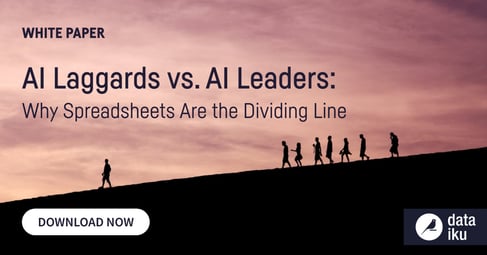Excel gained a significant amount of traction and became immensely popular among organizations for its ease of use and ability to perform lightweight data preparation functions, paving the way as a pioneering tool for data democratization within the enterprise. Over time, though, as data science, machine learning, and AI continued to advance and become more sophisticated, spreadsheets quickly became a glass ceiling for a multitude of today’s organizations aiming to become truly data driven.
As data executives and managers aim to arm their teams with the processes and tools to upskill their data education and simultaneously increase the organization’s AI maturity (leading to more use cases, models in production, higher ROI, and so on), it’s critical that they encourage the transition away from wonky spreadsheets into a scalable tool, such as an end-to-end data science platform.
What’s the reasoning behind that? Well, spreadsheets stand in the way of data-driven progress — they are error prone, cumbersome to maintain, and, ultimately, a source of immense productivity loss. Just recently, BBC News revealed that a spreadsheet error caused nearly 16,000 cases of COVID-19 to go unreported in England, meaning close contacts of those infected did not get notified that they might be at risk and should self-isolate for 14 days. On top of this being a blatant health and societal concern, the example demonstrates the damaging impacts (due to lack of data governance and human errors) associated with using spreadsheets.
In order to transition from creating time-consuming reports in spreadsheets or running macros that haven’t been updated in a decade, here are a few starter tips to keep in mind when looking for a collaborative data science platform:
- Bring data prep into the same place that machine learning is happening to projects can be iterated on, reused, and scaled in a much more agile manner
- Eliminate trust and security concerns by using a tool that documents data sources (i.e. those with PII), data lineage, and what data is being used in a what projects
- Seek a platform that helps you accelerate the time to value, not elongate it (and avoid spreadsheets crashing, frustrating formatting issues, and wasting precious manpower)
The only way teams of today (i.e. analysts or other business people) will be able to truly collaborate on enterprise-grade data projects with complex datasets is by streamlining that work into one tool so everything — from data prep to modeling and beyond — is visible in one place and there’s no need to toggle between tools. As a result, teams will be able to regain lost time, avoid duplicate work and capitalize on reuse, and become profitable with AI at a faster rate.





